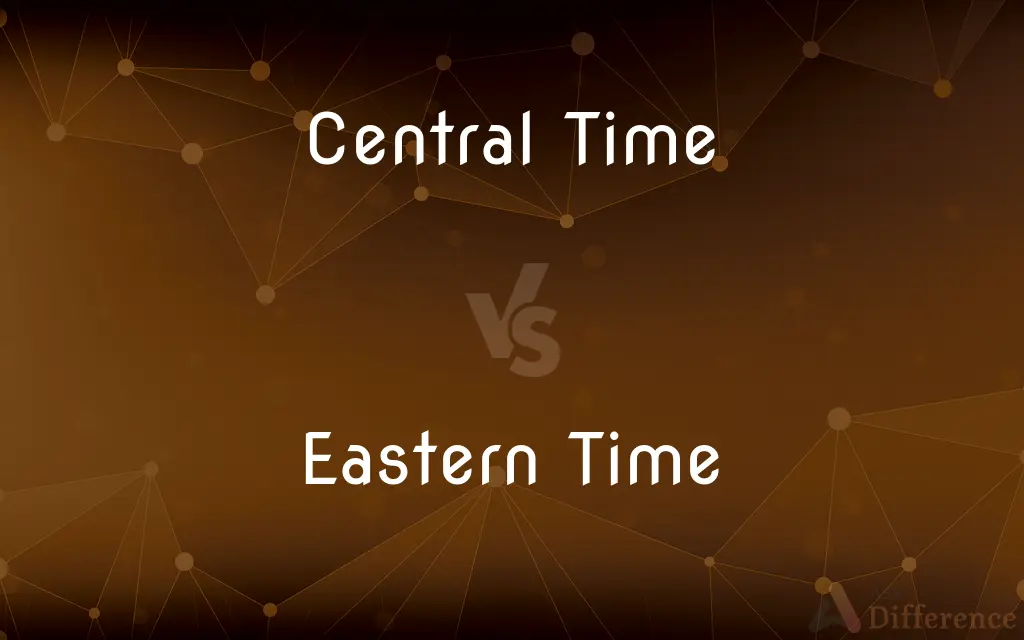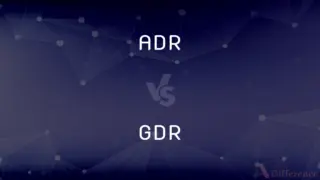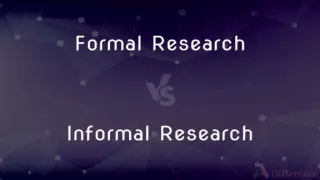Central Time vs. Eastern Time — What's the Difference?
Edited by Tayyaba Rehman — By Fiza Rafique — Published on December 29, 2023
Central Time is one hour behind Eastern Time; both are time zones in North America, with Eastern Time being ahead.

Difference Between Central Time and Eastern Time
Table of Contents
ADVERTISEMENT
Key Differences
Central Time and Eastern Time are two of the primary time zones in North America. Central Time (CT) is commonly used in the central part of the United States, encompassing states like Texas, Illinois, and Missouri. In contrast, Eastern Time (ET) covers the eastern portion, including states such as New York, Florida, and Georgia.
Central Time is characterized by being one hour behind Eastern Time. So, when it's 3:00 PM in Central Time, it's 4:00 PM in Eastern Time. This difference impacts various aspects, from television broadcasting schedules to business hours. For those working across these time zones, awareness of the hour's difference is crucial.
Additionally, Central Time and Eastern Time also witness daylight saving adjustments, although they follow the same guidelines. When daylight saving time is observed, both zones adjust their clocks, but the one-hour difference between them remains consistent.
Understanding the distinction between Central Time and Eastern Time is essential for travel, business, and communication purposes. With the U.S. being such a vast country, time zones help organize activities and synchronize events, ensuring that regions operate efficiently relative to their sun positioning.
Comparison Chart
Position
2nd time zone from the east coast
1st time zone, adjacent to the Atlantic coast
ADVERTISEMENT
Hour Difference
1 hour behind Eastern Time
1 hour ahead of Central Time
Typical States
Texas, Illinois, Missouri
New York, Florida, Georgia
Daylight Saving
Adjusted but remains 1 hr behind ET
Adjusted and stays 1 hr ahead of CT
Usage
Central part of the U.S.
Eastern part of the U.S.
Compare with Definitions
Central Time
Central Time is the time zone used in the central part of the United States.
When scheduling meetings, always consider the Central Time to accommodate attendees from the Midwest.
Eastern Time
Eastern Time is one hour ahead of Central Time.
If a conference starts at 10 AM Eastern Time, it's only 9 AM in Central Time.
Central Time
Central Time encompasses a vast region, from the Gulf of Mexico to Canada's border.
When traveling from Chicago to New Orleans, you'll remain in the Central Time zone.
Eastern Time
Eastern Time encompasses states from Florida to Maine in the U.S.
If you're flying from Miami to Boston, you'll remain in the Eastern Time zone throughout your journey.
Central Time
Central Time is one hour behind Eastern Time.
If it's 6:00 PM in Central Time, it's already 7:00 PM in New York.
Eastern Time
Eastern Time refers to the time zone covering the eastern portion of the United States.
New York City operates on Eastern Time, ensuring its bustling activities sync with the sun's position.
Central Time
Central Time observes daylight saving, adjusting clocks seasonally.
Don't forget to set your clocks ahead in the spring if you live in the Central Time zone.
Eastern Time
Eastern Time observes daylight saving, with clock adjustments.
Residents in the Eastern Time zone should remember to fall back in November.
Central Time
Central Time is significant for broadcasting schedules and travel itineraries.
TV shows might air at 7 PM Central Time and 8 PM Eastern Time.
Eastern Time
Eastern Time plays a pivotal role in U.S. financial activities since Wall Street operates in this zone.
Stock market activities start early in the morning, Eastern Time.
Common Curiosities
Which states predominantly use Eastern Time?
States like New York, Florida, and Georgia use Eastern Time.
Why are time zones like Central Time and Eastern Time important?
They help synchronize activities and events across vast regions.
Is Eastern Time ahead or behind Greenwich Mean Time (GMT)?
Eastern Time is GMT-5 during standard time and GMT-4 during daylight saving.
What's the primary difference between Central Time and Eastern Time?
Central Time is one hour behind Eastern Time.
When it's noon in Eastern Time, what time is it in Central Time?
It's 11:00 AM in Central Time.
Are there countries outside the U.S. that use Eastern Time?
Yes, parts of Canada and a few countries in the Caribbean use Eastern Time.
Is the entirety of a state always in one time zone?
Not always. Some states, like Indiana, have portions in different time zones.
How many time zones are there in the U.S.?
There are four primary contiguous time zones: Pacific, Mountain, Central, and Eastern.
Do both Central Time and Eastern Time observe daylight saving?
Yes, both time zones adjust for daylight saving.
How does the time difference impact TV broadcasting?
Shows might air an hour earlier in Central Time compared to Eastern Time.
What's the UTC offset for Central Time?
It's UTC-6 for standard time and UTC-5 for daylight saving.
Which is further west, Central Time or Eastern Time?
Central Time is further west.
Does the one-hour difference between Central Time and Eastern Time apply year-round?
Yes, the difference remains consistent, even during daylight saving adjustments.
How can someone keep track of different time zones like Central Time and Eastern Time?
Using world clocks, smartphone settings, or online time zone converters can help manage multiple zones.
Why might someone in Eastern Time need to be aware of Central Time?
For business meetings, communication, travel, and scheduling purposes with those in Central Time regions.
Share Your Discovery

Previous Comparison
ADR vs. GDR
Next Comparison
Formal Research vs. Informal ResearchAuthor Spotlight
Written by
Fiza RafiqueFiza Rafique is a skilled content writer at AskDifference.com, where she meticulously refines and enhances written pieces. Drawing from her vast editorial expertise, Fiza ensures clarity, accuracy, and precision in every article. Passionate about language, she continually seeks to elevate the quality of content for readers worldwide.
Edited by
Tayyaba RehmanTayyaba Rehman is a distinguished writer, currently serving as a primary contributor to askdifference.com. As a researcher in semantics and etymology, Tayyaba's passion for the complexity of languages and their distinctions has found a perfect home on the platform. Tayyaba delves into the intricacies of language, distinguishing between commonly confused words and phrases, thereby providing clarity for readers worldwide.














































